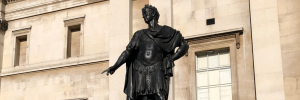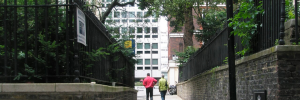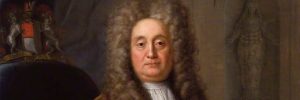There is a fine statue by Grinling Gibbons of Sir Robert Clayton on the northern edge of the site of St Thomas’s Hospital. The figure exudes an air of quiet authority standing with his head half turned away to his right. In his right hand, he holds a scroll, and he wears luxurious robes of office together with a lace collar and a resplendent long wig.
Clayton (1629-1707) was reputed to be the wealthiest man in London, owning a fine house in Old Jewry, which was noted for its sumptuous banqueting hall. He beginnings were modest with his father being described as a carpenter. However, his uncle Robert Abbott was a highly successful scrivener and took on the young Clayton in his service. Clayton became his chief clerk and on Abbott’s death inherited his business.
Abbott’s office was at the sign of Flying Horse in the parish of St Michael’s Cornhill. Scriveners provided a range of financial services including lending money, making investments and acting as land agents. Abbott had been an active Royalist and was condemned to death at one stage by the Parliamentarians. Clayton was able to exploit his uncle’s good name with Royalists trying to win back land which had been confiscated from them.
He earned a reputation for some sharp practices including taking excessive fees, and for lending money on the security of his clients’ deeds without troubling to gain their consent or remunerate them. Clayton carried out much charitable work. He was a governor of Christ’s Hospital where he founded a new girls’ ward, and the Royal Mathematical School for boys. He founded a third court at St Thomas’s, and the statue originally stood in the middle of this building on the original site near London Bridge, to commemorate his benefaction. He was also the president of the hospital.
Clayton’s prominence was reflected in his position as a governor of the Bank of England from 1702-7, and in his later years, he served as MP for Bletchingley and then for London.
Clayton’s rise to wealth was helped by marrying Martha Trott, the daughter of a prominent London tobacco trader. With his marriage, he received the ownership of a substantial plantation in Bermuda. He was also a director of the Royal Africa Company whose principal business was the transportation of slaves from the Guinea coast to the Caribbean.
The statue has been at its current, out-of-the-way site since 2000, reflecting the awkwardness of its owners, the Guy’s and St Thomas’ Foundation over a statue designed to celebrate the charitable works of a man intimately involved with slavery.

Listen to our London History Podcast Episode 126: Transatlantic Slave Trade and London




